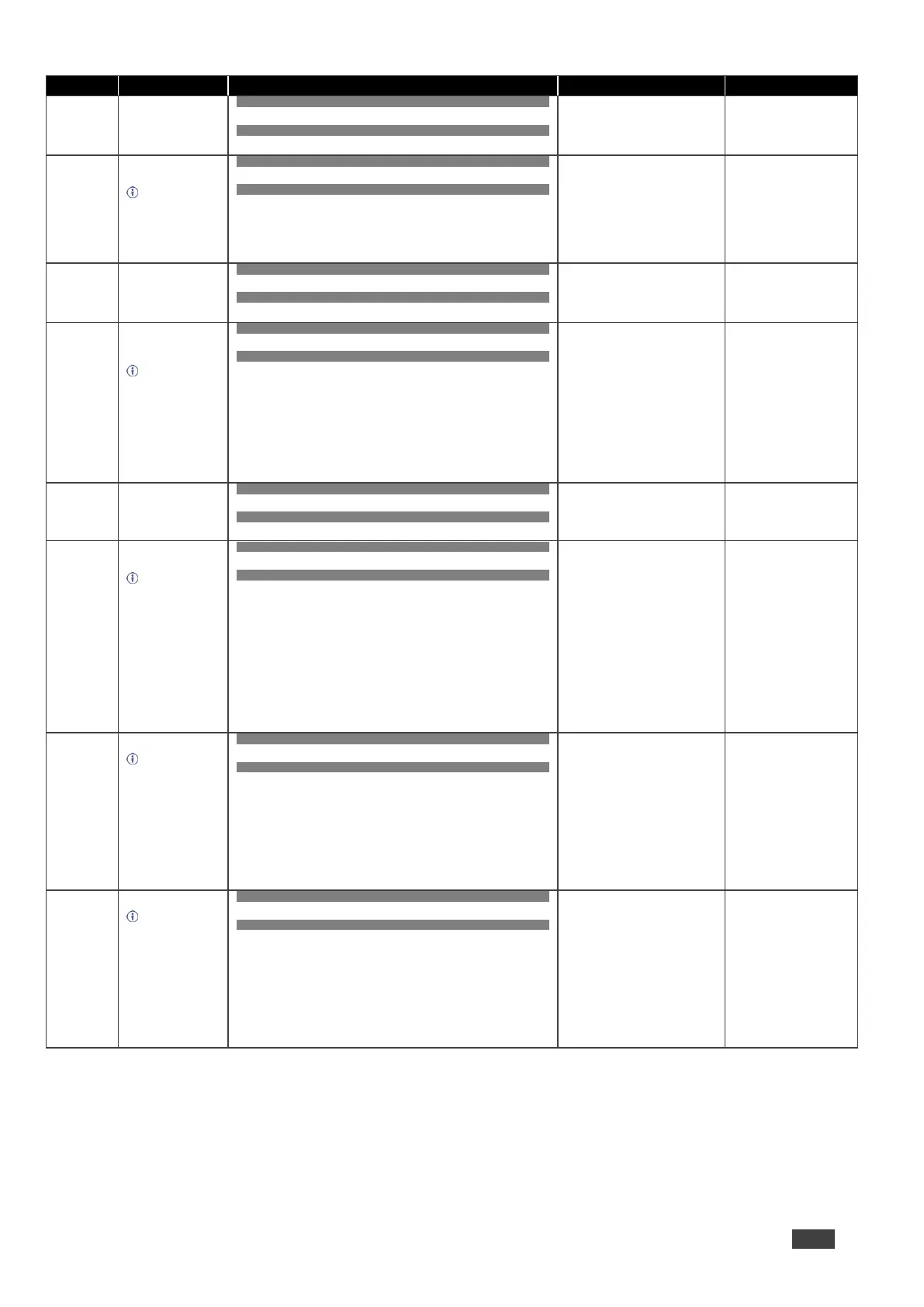VS-88H2 – Protocol 3000 Commands
Get the DIP-switch
state.
COMMAND
#DPSW-STATUS?dip_id<CR>
FEEDBACK
~nn@DPSW-STATUSdip_id,status<CR><LF>
dip_id – 1 to 8 (number of DIP
switches)
status – Up/down
0 – Up
1 – Down
get the DIP-switch 2 status:
#DPSW-STATUS?2<CR>
Set Ethernet port
protocol.
If the port number
you enter is already in
use, an error is
returned.
The port number must
be within the following
range: 0-(2^16-1).
COMMAND
#ETH-PORTport_type,port_id<CR>
FEEDBACK
~nn@ETH-PORTport_type,port_id<CR><LF>
port_type – TCP/UDP
port_id – TCP/UDP port number
(2000 – 65535)
Set the Ethernet port
protocol for TCP to port
12457:
#ETH-PORT0,12457<CR
>
Get Ethernet port
protocol.
COMMAND
#ETH-PORT?port_type<CR>
FEEDBACK
~nn@ETH-PORTport_type,port_id<CR><LF>
port_type – TCP/UDP
0 – TCP
1 – UDP
port_id – TCP / UDP port number
(2000 – 65535)
Get the Ethernet port
protocol for UDP:
#ETH-PORT?1<CR>
Reset device to
factory default
configuration.
This command
deletes all user data
from the device. The
deletion can take
some time.
Your device may
require powering off
and powering on for
the changes to take
effect.
COMMAND
#FACTORY<CR>
FEEDBACK
~nn@FACTORYok<CR><LF>
Reset the device to factory
default configuration:
#FACTORY<CR>
Get current FPGA
version.
COMMAND
#FPGA-VER?fpga_id<CR>
FEEDBACK
~nn@FPGA-VERfpga_id,expected_ver,ver<CR><LF>
fpga_id – FPGA id 1
expected_ver – Expected FPGA
version for current firmware
ver – Actual FPGA version
Get current FPGA version:
#FPGA-VER?1<CR>
Get EDID support on
certain input/output.
For old devices
that do not support
this command,
~nn@ERR
002<CR><LF> is
received.
COMMAND
#GEDIDio_mode,in_index<CR>
FEEDBACK
~nn@GEDIDio_mode,in_index,size<CR><LF>
io_mode – Input/Output
0 – Input
1 – Output
2 – Default EDID
in_index – Number that indicates
the specific input:
1 – HDMI IN 1
2 – HDMI IN 2
3 – HDMI IN 3
4 – HDMI IN 4
5 – HDMI IN 5
6 – HDMI IN 6
7 – HDMI IN 7
8 – HDMI IN 8
size – Size of data to be sent from
device, 0 means no EDID support
Get EDID support
information for HDMI IN 1:
#GEDID0,1<CR>
Set HDCP mode.
Set HDCP working
mode on the device
input:
HDCP supported -
HDCP_ON [default].
HDCP not supported -
HDCP OFF.
COMMAND
#HDCP-MODin_index,mode<CR>
FEEDBACK
~nn@HDCP-MODin_index,mode<CR><LF>
in_index – Number that indicates
the specific input:
1 – HDMI IN 1
2 – HDMI IN 2
3 – HDMI IN 3
4 – HDMI IN 4
5 – HDMI IN 5
6 – HDMI IN 6
7 – HDMI IN 7
8 – HDMI IN 8
mode – HDCP mode:
0 – HDCP Off
1 – HDCP On
Set the input HDCP-MODE
of HDMI IN 1 to Off:
#HDCP-MOD1,0<CR>
Get HDCP mode.
Set HDCP working
mode on the device
input:
HDCP supported -
HDCP_ON [default].
HDCP not supported -
HDCP OFF.
COMMAND
#HDCP-MOD?in_index<CR>
FEEDBACK
~nn@HDCP-MODin_index,mode<CR><LF>
in_index – Number that indicates
the specific input
1 – HDMI IN 1
2 – HDMI IN 2
3 – HDMI IN 3
4 – HDMI IN 4
5 – HDMI IN 5
6 – HDMI IN 6
7 – HDMI IN 7
8 – HDMI IN 8
mode – HDCP mode:
0 – HDCP Off
1 – HDCP On
Get the input HDCP-MODE
of HDMI IN 1:
#HDCP-MOD?1<CR>

